
Like the second sidefaces, the first pictorials were used for both postal and revenue purposes.
Due to its high value, there was little genuine postal demand for the 5/- value and so most were used fiscally. Hence collectors must be wary about cleaned fiscals, especially those that initially had a pen cancel. Some are offered unused while others have had a fake postmark applied.
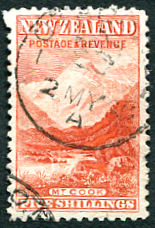
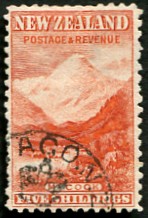
Even stamps with a genuine postmark should be treated with some suspicion as they were often cancelled to order or used philatelically on mail that required a far lower denomination.
For that reason, I personally believe that stamps bearing a clean genuine revenue cancellation are perfectly collectable and are certainly far superior to cleaned fiscals with a fake postmark. Some stamps used fiscally have a punched hole and are far less desirable.
Some fiscal cancellations look very like ordinary postmarks although any cancellation containing a crown is a fiscal. The two illustrated stamps were fiscally used in Otago.
Paying fines

The stamp on the left bears a Christchurch cancellation and appears to be postally used. However, I was told by the dealer who it sold to me that the standard fine for drunkenness in Christchurch at that time was five shillings and the 5/- stamp was used as a receipt for payment of the fine.
The post office was across the road from the court house
and the cancellation shown was the one usually applied.
He therefore sold it to me as a fiscal cancellation at a much lower price
than for a genuinely postally used stamp.
Embossing
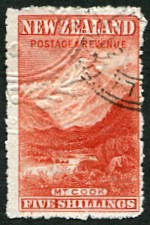
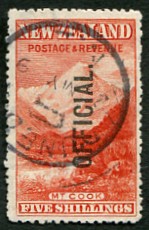
Fiscal stamps were often cancelled by being embossed with a fernleaf pattern as well as being cancelled by a conventional datestamp. The example on the right is embossed at the top left and cancelled at Wellington.
The stamp on the left is overprinted official and
has part of a large R under
Dunedin in the (inverted) cancellation.
The R does not however stand for Revenue, but
for Registered and this stamp was postally used on a
registered packet.
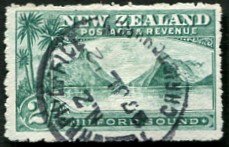
The 2/- value is also usually met fiscally used. The illustrated stamp has a Telegraph Office cancellation and so was presumably used to pay for a telegraph rather than to prepay postage.
Note that the date of use is 1912, the last year of use before
the 2/- pictorial was withdrawn to be replaced, even for postal purposes, by the 2/- revenue stamp.
Most of the first pictorials were replaced by the Edward VII
definitives in 1909.
The above information is taken from:
The Postage Stamps of New Zealand Vol 1, published by the
Royal Philatelic Society of New Zealand in 1938.
The 1898 Pictorial Issue of New Zealand, D. Diamond, published by the
New Zealand Society of Great Britain in 2014.
All scans were made by the author.